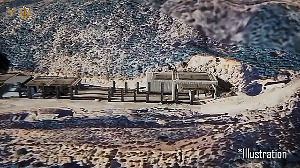 Ajay Mathur has brought in about 4,000 Mw into the electricity grid so far, which is equal to one ultra mega power plant costing about Rs 20,000 crore (Rs 200 billion) - if you go by the argument that energy saved is energy generated.
Ajay Mathur has brought in about 4,000 Mw into the electricity grid so far, which is equal to one ultra mega power plant costing about Rs 20,000 crore (Rs 200 billion) - if you go by the argument that energy saved is energy generated.
As the director general of the Bureau of Energy Efficiency (BEE), he increases the energy-saving target every year, which improves country's energy intensity as well as emissions intensity.
The market for energy efficiency products and services, and tradeable efficiency certificates - which India is going to launch - could be as large as Rs 74,000 crore (Rs 740 billion), he tells Vandana Gombar in an interview after his return from the Copenhagen climate change conference. Excerpts:
What did we achieve at Copenhagen?
While no legally binding agreement was reached, doors that were important to us have not been closed. The Kyoto protocol and its carbon markets have been important to us and the Copenhagen accord says that we will continue to talk on Kyoto. We were seeking a differentiation between developed and developing countries, and that has been maintained. From funding to forests to technology transfer to adaptation, negotiations on none of these have been closed. What is important now is that through all these doors, we are able to get the furniture that we believe is important.
Did India negotiate from a position of strength at Copenhagen?
In areas that were important to us, we batted from a position of strength, because we are a country that has already initiated action on climate change. We have already moved ahead, whether it is on mitigation, technology or adaptation. These were not merely flavours of the month for us.
India is committed to reducing emissions intensity. Does this have a direct one-to-one correlation with energy intensity?
The two are interlinked, but it is a complex linkage. Nevertheless, both of these are on a declining trend.
Take energy intensity first. Implementing the policies that we already have in place - like moving to more efficient supercritical power plants; halving transmission losses to 15 per cent; increasing energy efficiency of the industry and of the transport sector - would help us reduce energy intensity by 20-25 per cent by 2020.
Also, we are committed to reducing emissions intensity, which is emissions per rupee of GDP, by 20-25 per cent by 2020. However, only about 60 per cent of the green house gas emissions were from the energy sector. The rest are from sectors like animal husbandry and rice farming. We don't have the data for those emissions.
There are instances where energy intensity is improving while emissions intensity is deteriorating. Take the case of the poor using biomass, which is net zero on carbon dioxide. As they move to fossil fuel, where use is more efficient, energy intensity improves, but fossil fuel adds to emissions. The net impact needs to be analysed.
We have some of the most energy-efficient plants, in cement for instance, and some of the worst too. How would the National Mission on Energy Efficiency (which is part of the National Action Plan on Climate Change) tackle that?
Our problem is the bandwidth of energy efficiencies - from very efficient to very inefficient. So, the public policy problem is to bring the inefficient ones towards the efficient side. Work on the National Mission will kick off in April 2010 (which means money would become available) and we expect the Perform, Achieve and Trade or PAT mechanism to be operated from April 1, 2011.
How would it work? What would change on April 1, 2011 for the different energy guzzling industries?
There are 714 identified units - power plants, cement plants and fertiliser units - across nine sectors, which are the most energy-intensive units today. By April 1, 2011, we will have told them of the percentage reduction in their specific energy consumption they have to achieve over the next three years.
How are these specific targets being worked out? Will they be industry-specific or plant-specific?
The percentage reduction target would depend on how efficient that unit is compared to the most efficient unit in that sector. The most efficient one would have the smallest percentage reduction target and the least efficient will have the largest percentage reduction target.
For instance, the world's most energy-efficient cement plant and the second-most efficient plant are in India. They will have very small targets. However if you look at the paper industry, the most efficient plant is quite far from the global norms, so even the most efficient one would have a relatively large target.
How did you zero in on these 714 units?
We identified nine sectors which use the largest amount of energy - power stations, cement, steel, fertilisers, aluminium, chlor-alkali, paper, textiles and railways. Then, in each one of them, we established a threshold of energy consumption and those plants that used more energy than the threshold became part of our list of 714. They are called designated consumers under the Energy Conservation Act.
On another track, a controversy is brewing over BEE's plans to label automobiles for energy efficiency. Doesn't the mileage of the car establish its energy efficiency?
As a first step, you will look at the mileage. Labelling provides additional information. It tells you how energy-efficient the car is in a particular weight class, so that you don't end up comparing a Maruti 800 with an Esteem or with a Toyota Corolla.
The global experience is that with the availability of this information, consumers develop a preference to move towards more efficient cars within the same weight class, so we are moving towards lower energy intensity. We are working on a voluntary energy efficiency labelling programme for automobiles which will be finalised shortly, taking all reasonable points of view into consideration.
What is your estimate of the size of the energy-efficiency market, including products and services?
There is an estimated market size of Rs 74,000 crore (Rs 740 billion), though these numbers are always imprecise. It does, however, indicate that there is a huge market opportunity worth tens of thousands of crores.
Energy efficiency labelling has become mandatory for some products this year. What are the other milestones that have been set for 2010?
This year will see a new energy services company, Energy Efficiency Services Ltd (EESL), which will be promoted by National Thermal Power Corporation (NTPC), Rural Electrification Corporation (REC), Power Finance Corporation (PFC) and Powergrid. The Partial Risk Guarantee Fund (Rs 95 crore) and the Venture Capital Fund for Energy Efficiency (Rs 75 crore) will also start working.
For this year, we are also on track to deliver verified savings of 2,600 Mw, which is avoided capacity. In the first six months, avoided generation is already 1,350 Mw, which is more than last year's 1,200 Mw. For next year, we would probably do 4,000 Mw as we extend the energy efficiency labelling programme to newer segments, including buildings.
How do you push states on energy efficiency?
We have carried out a study on electricity savings potential in each of the 35 states and Union Territories, and an interesting thing is that in some states with large power shortages, the energy saving potential is larger than the shortage. We hope this will inspire the states and their chief ministers to adopt and implement energy efficiency programmes.










 © 2025 Rediff.com -
© 2025 Rediff.com -